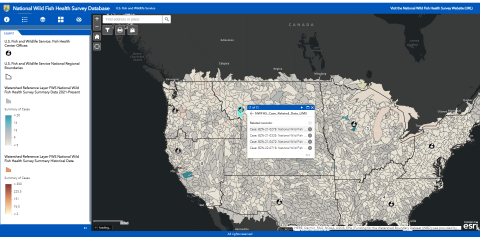The U.S. Fish and Wildlife Service’s fish health centers have launched a new tool to help in the fight to protect wild fisheries. The Wild Fish Health Survey Mapper provides real-time surveillance of pathogens in wild aquatic animal populations. As climate change climate change
Climate change includes both global warming driven by human-induced emissions of greenhouse gases and the resulting large-scale shifts in weather patterns. Though there have been previous periods of climatic change, since the mid-20th century humans have had an unprecedented impact on Earth's climate system and caused change on a global scale.
Learn more about climate change drives human, animal, and disease migrations, the data collected by the National Wild Fish Health Survey will become increasingly important in our efforts to conserve freshwater fish and aquatic species for future generations.
For most of the 20th century, very little was known about the presence or distribution of naturally occurring viruses and pathogens that cause diseases in wild fish. That lack of knowledge put conservation efforts at risk because natural resource managers often have to move fish and other aquatic animals between hatcheries and ecosystems in order to support Tribal and recreational fisheries and conserve some of the most imperiled organisms in the world.
Since 1997 the U.S. Fish and Wildlife Service’s fish health centers have conducted a National Wild Fish Health Survey to improve our ability to conserve fish and waterways. The survey provides information on the presence or absence of aquatic animal pathogens in wild fish populations to Tribes, state and federal fisheries managers, the aquaculture industry, conservation groups, researchers, and the public. This information helps to better manage both hatchery and wild fish populations.
In 2020, this publicly accessible database was upgraded and fully integrated within a U.S. Fish and Wildlife supported GIS system. The GIS based system allows researchers, state fisheries managers, and the public to search, explore, and download the data for further analysis.
Explore the National Wild Fish Health Survey
The information collected by the National Wild Fish Health Survey helps biologists and fisheries managers decide where and how to manage aquatic animals and to model for future pathogen occurrences. This data can help to establish safe zones and areas where movement of aquatic animals can take place without endangering the health of wild fish populations. This is the only such information available and it is the oldest data set of this nature existence.
The National Wild Fish Health Survey database would not be possible without the support and cooperation of Tribes, states, and the aquaculture industry. For information or questions contact: wildfishsurvey@fws.gov




